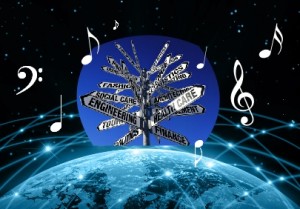My friend Mary was once cornered by a 4th grade student who told her, “You’re pretty smart, for a music teacher.”
Mary asked the little girl why she thought most music teachers weren’t so smart.
“Because you only teach singing and playing instruments. Can you multiply? Can you divide? Can you do fractions?”
This tells us quite a bit about our compartmentalized world! The little girl was learning about music but was not aware of the connecti ons music has with everything else.
ons music has with everything else.
Linking music learning to people’s work lives, to school subjects, to decisionmaking, to learning — all these help people learn music better, and makes for better-rounded individuals.
Below are some connections that might provide food for thought on this subject…
Math: The little girl asked about fractions so let’s start there! This connection could be easy to make clear — music divides and subdivides constantly along a timeline. We work with whole, half, quarter, eighth, sixteenth notes, and multiple ways to combine them or add a dot to increase a note’s value by 50%. More importantly, perhaps, music makes counting physical. Many musicians do not actually count numbers while playing but rather feel and work with beats and fractions of beats in a more sensory way. Maybe this is why many musicians are so intuitively good at math.
English: Musical expression matches up with linguistics, with words and phrases of language — most obviously when there are lyrics to a melody, but also in music without words. In a song, shifts of note values from one verse to another easily show how music relates to the expression of different ideas through words, with changing rhythms from syllable to syllable. With or without lyrics, musicians hear and play phrases with the same intention people have when speaking or singing. We use pickup notes the way we use conjunctions like “if”, “and” or “but. We use grace notes before a beat the way we sound consonants before a vowel; and we shift rhythms as needed, just as when speaking, we might insert a word within the “measure” — e.g. we can adjust instantaneously from “CROSS the STREET” (6/8 time) to “DON’T cross the STREET” (2/4 time) when a car is spotted careening down the road.
Public Speaking: Music is only communicated effectively when the timing is clear, just as a public speech only works when it is delivered with convincing phrasing and tempo.
Television and Film: These media are nothing without musical soundtracks to support the story line and convey the emotional significance of what is happening, and foreshadow what is about to happen. Music on its own is often perceived in the same way, and it is played better when a storyline is in the mind of the musician.
Physics: Music only exists because of sound waves. The physics of vibrations, and the various combinations of multiple vibrations has a powerful impact on our feeling for music. The physics of shortening or lengthening strings or columns of air, or of creating nodes to force a string to vibrate in harmonics — these scientific facts are what governs the learning and playing of a musical instrument, and can be used to help students understand the science behind them.
Biology: Breathing is inherent in music; it’s built into the flow of singing, playing, and dancing to music. Many biological functions are clearly musical — singing birds are the most obvious, or crickets, or frogs — but also the vibrations created by a bee or fly, who flaps wings at about 200 beats per minute and therefore can be imitated by playing a G or G#; or the mosquito which beats its wings at 600 times per minute, approximately a D#.
Social Studies: The playing of music with others, whether in an ensemble, or a theatrical production, or a spontaneous session — these are studies in group dynamics, leadership, and political interactions.
Business: No working musician can get by without using graphics, marketing, contracts, accounting. At some level all musicians are entrepreneurs.
Teaching: All the skills of teaching any subject, and an understanding of the science of learning, are needed for successful teachers of music.
Psychology: Whether establishing a rapport with an audience, or probing the needs of a music student, musicians develop strong skills in psychology. Some students use music quite directly as personal life therapy and depend on their teachers to help them with their communication and thinking problems.
Parapsychology: one of the only peer-reviewed studies of ESP found significant ability among musicians at Juilliard to sense what slide was being shown in the neighboring room. If true, what does this say about the skills of musicians to sense the needs and intentions of others around them, whether in a musical performance or otherwise?
Social Work: Music therapists make direct use of music to treat patients in psychiatric or geriatric treatment in hospitals, nursing homes or chronic care facilities. They improve patients’ daily lives and help them work through problems they have a hard time confronting any other way.
© Ed Pearlman 2015